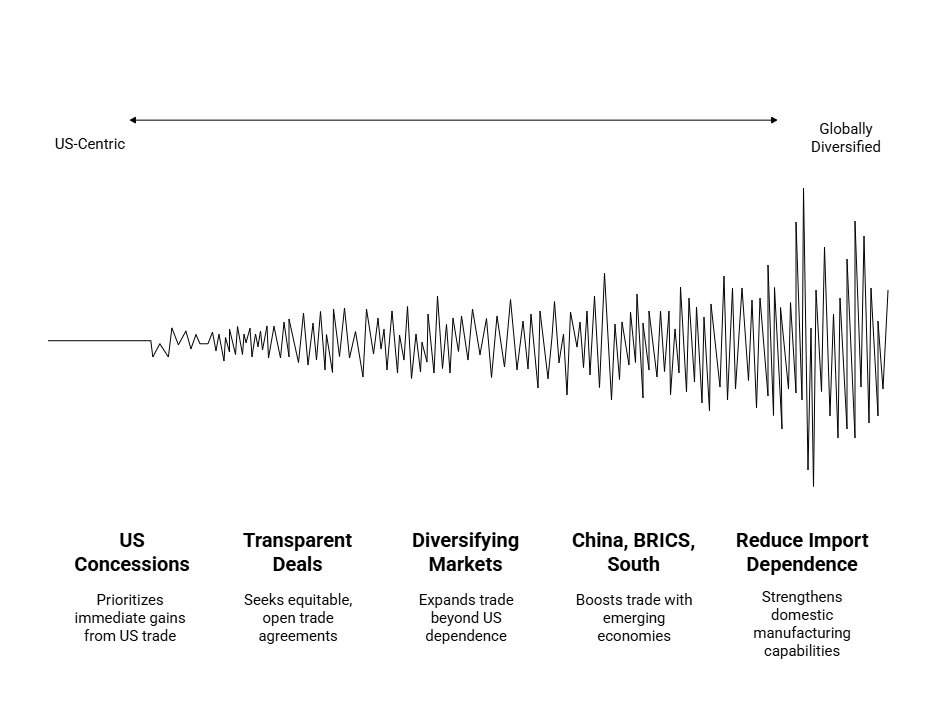Paper: GS – III, Subject: Economy, Topic: Trade and External sector, Issue: India-USA trade deal.
Context:
On 7 July 2025, US President Donald Trump announced steep tariffs (25–40%) on imports from 14 countries (India, Japan, South Korea, Malaysia, etc.), as part of his ‘Liberty Steel Tariff Day’ offensive, escalating trade protectionism.
Key Highlights:
India’s Trade Position with US:
- Exports: India exports $86 billion worth of goods to the US.
- Concern with sensitive sectors: Sensitive sectors like dairy, agriculture, and GM crops are excluded from trade deal discussions, to protect domestic interests.
- Maximising benefits: India aims to maximize benefits without compromising sovereignty.
Concerns Over the Proposed Deal:
- Non-Reciprocity: The deal appears rushed and unbalanced, lacking mutual reciprocity.
- Limited integration: Likely to be tariff-focused, rather than enabling deeper economic integration.
- Market access concerns: India may lower tariffs from 26% to 10% but retain US MFN (Most Favoured Nation) tariffs—limiting real market access for Indian exports.
Limitations of the Trade Deal
- Lack of compliance: The proposed deal will not qualify as a Free Trade Agreement (FTA) under WTO norms as it does not cover “substantially all trade.” It also violates WTO’s MFN rule.
- Lack of reciprocal commitments: India may concede investment and digital trade relaxations without clear reciprocal US commitments.
- Legal and accountability issues: Trump’s deals tend to exclude legal accountability and have precedents of violations (e.g., with Japan, South Korea, Vietnam).
Implications if No Deal is Reached:
- Tariff threat: India faces steep US tariffs starting 1 August 2025 on major goods which would affect India’s key exports and trade competitiveness.
- Weaponizing trade: The US might weaponize regulatory compliance to further restrict Indian goods.
Geopolitical dimension of the trade deal:
- Leading BRICS Presidency: India to lead BRICS presidency next year and aims to:
- Strengthen Global South’s trade resilience.
- Be the voice for equitable global trade.
- Trump’s move contrasts India’s effort to reform multilateralism and promote South-South cooperation.
Legal aspects of the trade deal:
- Illegality of the trade deal: US tariffs on “national security” grounds were ruled illegal by WTO (May 2024).
- Violates WTO norms: The US is resisting WTO decisions, further undermining multilateral trade norms. A US court put a temporary stay on this WTO ruling.
India’s options:

Conclusion:
The most likely outcome is a “Masala Deal”—a Mutually Agreed Settlement (MAS) that’s cosmetic, temporary, and prone to US arm-twisting. India must resist entering unbalanced trade pacts and stay committed to its long-term strategic and economic goals.
La Excellence IAS Academy, the best IAS coaching in Hyderabad, known for delivering quality content and conceptual clarity for UPSC 2025 preparation.
FOLLOW US ON:
◉ YouTube : https://www.youtube.com/@CivilsPrepTeam
◉ Facebook: https://www.facebook.com/LaExcellenceIAS
◉ Instagram: https://www.instagram.com/laexcellenceiasacademy/
GET IN TOUCH:
Contact us at info@laex.in, https://laex.in/contact-us/
or Call us @ +91 9052 29 2929, +91 9052 99 2929, +91 9154 24 2140
OUR BRANCHES:
Head Office: H No: 1-10-225A, Beside AEVA Fertility Center, Ashok Nagar Extension, VV Giri Nagar, Ashok Nagar, Hyderabad, 500020
Madhapur: Flat no: 301, survey no 58-60, Guttala begumpet Madhapur metro pillar: 1524, Rangareddy Hyderabad, Telangana 500081
Bangalore: Plot No: 99, 2nd floor, 80 Feet Road, Beside Poorvika Mobiles, Chandra Layout, Attiguppe, Near Vijaya Nagara, Bengaluru, 560040
